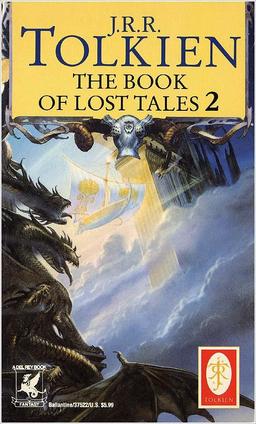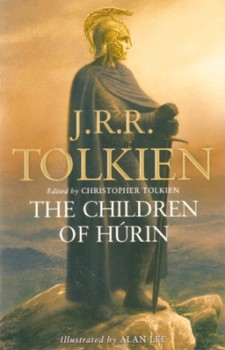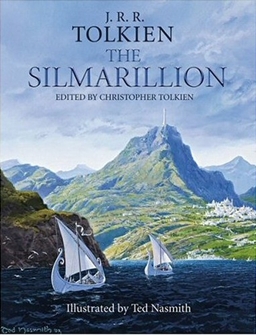The Public Life of Sherlock Holmes: Tolkien’s Necklace of the Dwarves
 I was a voracious reader of fantasy in my teens and early twenties. Moorcock, Tolkien, Lieber, Kurtz, Feist, Eddings, Brooks, Donaldson, Dragonlance and Forgotten Realms, Thieves World, Heroes in Hell; I devoured series fantasy. And later I would delve into McKiernan, Cook, Howard, Jordan and others.
I was a voracious reader of fantasy in my teens and early twenties. Moorcock, Tolkien, Lieber, Kurtz, Feist, Eddings, Brooks, Donaldson, Dragonlance and Forgotten Realms, Thieves World, Heroes in Hell; I devoured series fantasy. And later I would delve into McKiernan, Cook, Howard, Jordan and others.
Now, in the past decade, I’ve made a couple of attempts to re-read The Hobbit and The Lord of the Rings, but given up each time (I can say the same thing about Fritz Lieber’s Fafhrd and Grey Mouser series). I like the stories and the events, but parts of them just read so sloooow. I’ve not run into that problem with Michael Moorcock’s Eternal Champion series, or Katherine Kurtz’s Deryni books. But I’m still a huge Tolkien fan, even though I don’t sit down and read through him any more.
I’m in a rather small minority that prefers The Silmarillion to his two better-known works. And that’s because I’m completely sold on Tolkien as a world builder and storyteller. That’s why he’s still a favorite.
From the story of the Silmarils up to the start of the Third Age, Tolkien set the standard for world building and epic history. I enjoy the vast creations of Robert Jordan, Steven Erickson, Stephen R. Donaldson, David Eddings and many more, but Tolkien was unsurpassed.
One of my first Dungeons and Dragons characters was an elf named Gil Galad, wielding his spear, Aeglos. Fingolfin, the Sons of Feanor, Hurin, Turin, Melkor, Ancalagon, and Glaurung: The Silmarillion is just chock full of heroes, villains, lands, kingdoms and events.
Have you read of Beren and Luthien? You talk about the makings of a superb romantic fantasy! And The Children of Hurin could be the next Peter Jackson movie, depressing as it is (if Christopher Tolkien wasn’t dead set against Jackson touching The Silmarillion). While I could do without ever reading about Tom Bombadil again in The Hobbit, the epic sagas and the disparate characters that struggle through them mark Tolkien as a master. There are many ‘short stories’ in chapters of The Silmarillion that could be novellas, or full-length novels, though some are only a few pages long.
Nauglamir, The Necklace of the Dwarves, takes up parts of five pages in The Silmarillion. But it’s an entire saga. The dwarves of the Blue Mountains made this stunning necklace for the Elf Lord, Finrod. He gave them priceless jewels from Valinor to include and the necklace was the finest item crafted by dwarves in the First Age. We’re talking prime jewelry here.
When the fortress city of Nargothrond fell to Glaurung and an orc army, Nauglamir became part of the dragon’s horde. After Glaurung’s death, Hurin came to Nargothrond and left with but one treasure: Nauglamir. He took it to the elven kingdom of Doriath and gave it to its ruler, Thingol.
 Thingol had one of the three Silmarilli, the greatest creations of the elves. They were radiant jewels. The dwarves of Nogrod visited Doriath and agreed to incorporate the Silmaril of Beren and Luthien into it. But once they did so, they lusted for it and demanded it as their payment.
Thingol had one of the three Silmarilli, the greatest creations of the elves. They were radiant jewels. The dwarves of Nogrod visited Doriath and agreed to incorporate the Silmaril of Beren and Luthien into it. But once they did so, they lusted for it and demanded it as their payment.
Doriath (a bit clueless) insulted them and ordered them out of his kingdom. So, predictably, they slew him and fled with the priceless necklace. But the elves rose up and reclaimed the necklace, killing the fleeing party; only two dwarves managing to escape the slaughter.
And those two dwarves crafted their own “truth,” telling that Thingol had ordered the dwarves slain to avoid paying them for their work. The dwarves, enraged, took an army to Doriath. They emerged victorious in The Battle of the Thousand Caves and sacked the capital, Menegroth, carrying off a great treasure, including Nauglamir.
But the human lord Beren gathered an elven army and slaughtered the dwarves at a river crossing, completely eradicating the Nogrod army, with Beren killing the Dwarf Lord himself and taking Nauglamir, which he gave to Luthien. And lo, it was the very same Simaril that Beren had cut from Morgoth’s crown, but lost when the great wolf Carcaroth ate his hand, which clutched the jewel! Seriously: there’s a LOT going on here.
There’s more, with the sons of Feanor (creator of the Silmarilli) slaying their elven brethren (including Beren and Luthien’s son) to get the jewel. But Beren and Luthien’s daughter escaped with it, throwing herself into the sea. But even then, the story wasn’t done. I’m telling you, this is just one little piece of The Silmarillion, but it’s an epic story worthy of its own book!
This was the final, edited and canonical version included in The Silmarillion. And it’s a riveting tale. But all that evolved from a separate notebook titled, “The Nauglafring: The Necklace of the Dwarves.” That story is told in The Book of Lost Tales 2 (which became the second volume in The History of Middle Earth).
In this version, Thingol is Tinwelint (man, that is a terrible name) and instead of just the necklace of the dwarves, there’s a huge pile of treasure involved. His wife tells him there’s blood on the treasure and that it’s cursed. So, Tinwelint decides to throw it all in the river. Except he wants to see it one more time and can’t overcome his greed. That certainly won’t end well.
Unfortunately, Tinwelint is a greedy fool (though he’s really ensorcelled by the treasure’s bloody and evil history) and an elf named Ufedihn stirs the pot. I believe that here we actually have the first-ever mention of dwarves and he convinces Tinwelint to send the treasure horde to them to fashion wonders from. The greedy Tinwelint agrees, but holds Ufedihn hostage until his treasure is returned.
The dwarves perform their task, bring the goods back, then offer to make a wonderful necklace if Tinwelint will let them incorporate the Silmaril into it.
 But with ill-intended encouragement from Ufedihn, they demand an extravagant payment for their service, including elf maidens for wives.
But with ill-intended encouragement from Ufedihn, they demand an extravagant payment for their service, including elf maidens for wives.
Tinwelint is pissed and gives them a miniscule payment at a feast in their honor, where he forces them to toast him. Of course, this breeds bitter resentment in them. So, the dwarves form alliances with orcs, goblins and some of Melkor’s followers. One of Tinwelint’s elves betrays him to this alliance and they kill Tinwelint and sack the city.
Ulfedhin’s greed is too great and he attempts to murder the dwarven chieftain on their way back home. But he fails and flees. Which is good, because in this version also, Beren and the elves slaughter the entire dwarven army and recover the necklace.
There are a few more bits, but the original version puts a bit more blame on the elven king, while still casting the dwarves as greedy and even worse in taking on evil allies. Ulfedhin is an interesting character who is totally removed from the final version. There’s a bit of a Loki feel to him.
The Nauglamir is the stuff of an absorbing novel, with elves, dwarves, greed, treachery, romance, heroes and villains, combat: and this is just one little bit of The Silmarillion. And a part of it is just a fragment of Beren’s life (there’s a tale for another novel or two)!
I’m not crazy about the creation aspect at the beginning of The Silmarillion, but if you like history, the rest of the book is a fascinating read on a grand scale.
I haven’t read all of the books, and you really have to pick and choose what to read within a book, but I like Christopher Tolkien’s twelve-book The History of Middle Earth series. I do think there is much for the fan of Tolkien to learn, though it’s likely that a sizable chunk will be of less interest.
You can read Bob Byrne’s ‘The Public Life of Sherlock Holmes’ column here at Black Gate every Monday morning.
He founded www.SolarPons.com, the only website dedicated to the ‘Sherlock Holmes of Praed Street’ and blogs about Holmes and other mystery matters at Almost Holmes.
His “The Adventure of the Parson’s Son” is included in the largest collection of new Sherlock Holmes stories ever published.
I always wondered if Tolkien was doing a riff on the Norse Brisingamen with Nauglamir.
Akomins- He certainly delved deeply into Nordic stuff: wouldn’t surprise me a bit.
Bob, why don’t you have the patience for a long, slowly-developing narrative anymore, where once you did? What has changed? (I tend to find myself in the opposite situation – I love whopping Victorian novels with their drawn-out denouncements, and find myself bored with the short, sharp stuff.)
Thomas – I think my appreciation of writing styles has changed. I don’t mind some development: I read mysteries with that kind of build up.
But with Tolkien, I find myself skimming sentences to move along. Not all authors I re-read induce this in me, but I’ve definitely found it with Tolkien and Lieber.
Since I posted on Tolkien, I’ll add something else here in the comments.
While Tolkien greatly influenced fantasy, there have been no official continuations or pastiches of The Lord of the Rings, The Hobbit or The Silmarillion (I’m sure there’s fan fiction out there, but I’ve no desire to look for it).
If you read this column, you know that I’m a big Solar Pons guy. And Pons is a pastiche of Sherlock Holmes. The best one, as far as I’m concerned.
Dennis L. McKiernan’s Mithgar books are as close to a Tolkien pastiche as I think we’re going to get – without an official authorization.
(Yes, I know about The Sword of Shanarra, which I love: but Terry Brooks went on to create a series that stood on its own and moved away from Tolkien).
McKiernan wrote a sequel to The Lord of the Rings: a duology which became The Silver Call. The Tolkien Estate denied him permission, so he changed it enough that it was very Tolkien-like, but was different enough that his publisher could sell it.
That duology actually sat on the shelf while McKiernan wrote The Iron Tower trilogy, which was published first. Then the Silver Call (which occurs later) followed.
Nearly a dozen more books followed, set in the world of Mithgar. This series is quite Tolkien-esque and for someone looking to read “more Tolkien,” this is probably the place to go.
I’ve read most of the series, and I’ve liked most of what I’ve read. Dragon Doom is the best of the bunch and approaches literature more than the others. The Silver Call is for those (like me) who want more of the ‘Moria experience.’ And The Iron Tower trilogy is a LOTR-like experience. And Eye of the Hunter approaches dark fantasy, from a Tolkien viewpoint.
Dear Mr. Byrne,
I, too, put The Silmarillion at the top of my Tolkien reading pile. I enjoy the language as much as the worldbuilding, as sonorous as a Norse saga. I still do like the Lord of the Rings, and I have come to appreciate The Hobbit, which I was too young to appreciate when I was a teenager.
Oh, and Tom Bombadil is not in The Hobbit, though Beorn is. While I do understand Peter Jackson’s decision to not include Tpm Bombadil in his LotR films, I cannot help but be charmed by the old hippie spirit. Or perhaps I am thinking of Tim Benzedrine from Bored of the Rings.
Hi Eugene – I know that Tom Bombadil is in The LOTR – I was cutting a wide Tolkien swath. But I wanted to highlight that as an example of Tolkien I just have to wade through – or skip. And I rarely skip whole paragraphs or sections of a book.
Bored of the Rings – That slim volume is quite a fun read!
I’ve often thought the Beren and Luthien story would be the right length for a stand-alone feature film. Peter Jackson is not the guy to do it, though. The thread of earthy humor in LOTR and The Hobbit simply isn’t in The Silmarillion, and reducing the lovers’ confrontation with Morgoth himself to a boss fight (which the post-Hobbit Peter Jackson would surely do) would be about as much in the spirit of the original text as adding an orc burlesque number would be. Come to think of it, I would no longer put it past Peter Jackson to add an actual orc burlesque number.
Oh, I’d be fine with Jackson. Carcaroth, Finrod and his companions in the dungeon, being killed by the werewolves: there’s plenty of Jackson-esque stuff in the story.
I know it’s a love story, but I’d want all the action as well. That’s just me.
There’s got to be a director out there who can balance action, love story, and sensawunda.
[…] J.R.R. Tolkien’s word building and history development in ‘The Silmarillion’ and wrote about one piece of it regarding the famed ‘Necklace of the […]
Next year, another part of the Silmarillion, the story of Beren and Luthien, is being released as a fully fleshed out tale, as was ‘The Children of Hurin.’ I’m in.
https://smile.amazon.com/Beren-Luthien-J-R-Tolkien/dp/0008214190/ref=sr_1_1?ie=UTF8&qid=1483014645&sr=8-1&keywords=tolkien+beren
This spring, I dug into the Books of Lost Tales and a few of the History of Middle Earth series. My admiration for Tokien’s world building and crafting of tales is only growing. Great stuff.
I’m not too enamored with all the poetry, though.